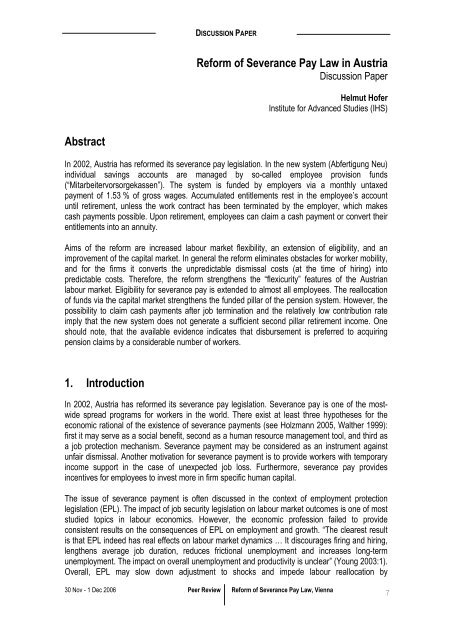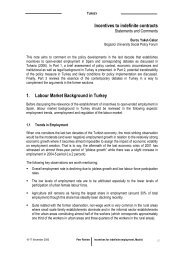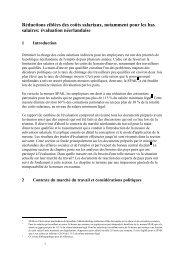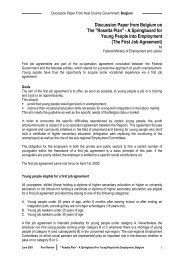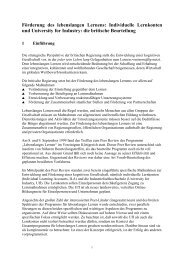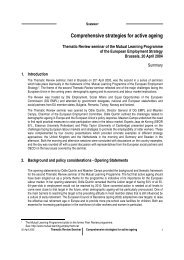Reform of Severance Pay Law in Austria - mutual learning programme
Reform of Severance Pay Law in Austria - mutual learning programme
Reform of Severance Pay Law in Austria - mutual learning programme
You also want an ePaper? Increase the reach of your titles
YUMPU automatically turns print PDFs into web optimized ePapers that Google loves.
DISCUSSION PAPER<br />
<strong>Reform</strong> <strong>of</strong> <strong>Severance</strong> <strong>Pay</strong> <strong>Law</strong> <strong>in</strong> <strong>Austria</strong><br />
Discussion Paper<br />
Helmut H<strong>of</strong>er<br />
Institute for Advanced Studies (IHS)<br />
Abstract<br />
In 2002, <strong>Austria</strong> has reformed its severance pay legislation. In the new system (Abfertigung Neu)<br />
<strong>in</strong>dividual sav<strong>in</strong>gs accounts are managed by so-called employee provision funds<br />
(“Mitarbeitervorsorgekassen”). The system is funded by employers via a monthly untaxed<br />
payment <strong>of</strong> 1.53 % <strong>of</strong> gross wages. Accumulated entitlements rest <strong>in</strong> the employee’s account<br />
until retirement, unless the work contract has been term<strong>in</strong>ated by the employer, which makes<br />
cash payments possible. Upon retirement, employees can claim a cash payment or convert their<br />
entitlements <strong>in</strong>to an annuity.<br />
Aims <strong>of</strong> the reform are <strong>in</strong>creased labour market flexibility, an extension <strong>of</strong> eligibility, and an<br />
improvement <strong>of</strong> the capital market. In general the reform elim<strong>in</strong>ates obstacles for worker mobility,<br />
and for the firms it converts the unpredictable dismissal costs (at the time <strong>of</strong> hir<strong>in</strong>g) <strong>in</strong>to<br />
predictable costs. Therefore, the reform strengthens the “flexicurity” features <strong>of</strong> the <strong>Austria</strong>n<br />
labour market. Eligibility for severance pay is extended to almost all employees. The reallocation<br />
<strong>of</strong> funds via the capital market strengthens the funded pillar <strong>of</strong> the pension system. However, the<br />
possibility to claim cash payments after job term<strong>in</strong>ation and the relatively low contribution rate<br />
imply that the new system does not generate a sufficient second pillar retirement <strong>in</strong>come. One<br />
should note, that the available evidence <strong>in</strong>dicates that disbursement is preferred to acquir<strong>in</strong>g<br />
pension claims by a considerable number <strong>of</strong> workers.<br />
1. Introduction<br />
In 2002, <strong>Austria</strong> has reformed its severance pay legislation. <strong>Severance</strong> pay is one <strong>of</strong> the mostwide<br />
spread programs for workers <strong>in</strong> the world. There exist at least three hypotheses for the<br />
economic rational <strong>of</strong> the existence <strong>of</strong> severance payments (see Holzmann 2005, Walther 1999):<br />
first it may serve as a social benefit, second as a human resource management tool, and third as<br />
a job protection mechanism. <strong>Severance</strong> payment may be considered as an <strong>in</strong>strument aga<strong>in</strong>st<br />
unfair dismissal. Another motivation for severance payment is to provide workers with temporary<br />
<strong>in</strong>come support <strong>in</strong> the case <strong>of</strong> unexpected job loss. Furthermore, severance pay provides<br />
<strong>in</strong>centives for employees to <strong>in</strong>vest more <strong>in</strong> firm specific human capital.<br />
The issue <strong>of</strong> severance payment is <strong>of</strong>ten discussed <strong>in</strong> the context <strong>of</strong> employment protection<br />
legislation (EPL). The impact <strong>of</strong> job security legislation on labour market outcomes is one <strong>of</strong> most<br />
studied topics <strong>in</strong> labour economics. However, the economic pr<strong>of</strong>ession failed to provide<br />
consistent results on the consequences <strong>of</strong> EPL on employment and growth. “The clearest result<br />
is that EPL <strong>in</strong>deed has real effects on labour market dynamics … It discourages fir<strong>in</strong>g and hir<strong>in</strong>g,<br />
lengthens average job duration, reduces frictional unemployment and <strong>in</strong>creases long-term<br />
unemployment. The impact on overall unemployment and productivity is unclear” (Young 2003:1).<br />
Overall, EPL may slow down adjustment to shocks and impede labour reallocation by<br />
30 Nov - 1 Dec 2006 Peer Review <strong>Reform</strong> <strong>of</strong> <strong>Severance</strong> <strong>Pay</strong> <strong>Law</strong>, Vienna<br />
7
DISCUSSION PAPER<br />
discourag<strong>in</strong>g hir<strong>in</strong>g and fir<strong>in</strong>g. This could have negative implications for productivity growth and<br />
adoption to technological change. On the other hand, EPL could provide <strong>in</strong>centives for employees<br />
to participate <strong>in</strong> tra<strong>in</strong><strong>in</strong>g, if there is <strong>in</strong>sufficient <strong>in</strong>surance aga<strong>in</strong>st loss <strong>of</strong> firm-specific human<br />
capital. The key issue for policy is how to reconcile the employers’ need for flexibility <strong>in</strong> hir<strong>in</strong>g and<br />
fir<strong>in</strong>g with that <strong>of</strong> workers for employment security. Blanchard and Tirole (2004) discuss<br />
unemployed <strong>in</strong>surance and EPL together <strong>in</strong> a framework with risk-averse worker and risk-neutral<br />
entrepreneurs. They claim that a lay<strong>of</strong>f tax can be efficiency enhanc<strong>in</strong>g, lead<strong>in</strong>g firms to<br />
<strong>in</strong>ternalise the costs <strong>of</strong> unemployment.<br />
Accord<strong>in</strong>g to the OECD (2006) severance payment can be a barrier to efficiency-enhanc<strong>in</strong>g<br />
labour reallocation by discourag<strong>in</strong>g workers from quitt<strong>in</strong>g their current jobs to move to better jobs.<br />
This problem arises where high tenure workers are entitled to significant severance payments, if<br />
they are laid-<strong>of</strong>f from the current job, but loose this entitlement if they voluntarily quit jobs. Aga<strong>in</strong>st<br />
this background the OECD (2006) mentioned the reform <strong>of</strong> severance pay <strong>in</strong> <strong>Austria</strong> as<br />
address<strong>in</strong>g this problem. <strong>Austria</strong> has reformed its severance pay legislation by chang<strong>in</strong>g from a<br />
performance-oriented to a contribution-oriented system <strong>of</strong> <strong>in</strong>dividual sav<strong>in</strong>gs accounts. The<br />
reform extends the coverage <strong>of</strong> the system to all employees <strong>in</strong> the private sector, but lower<br />
average payments are expected.<br />
In this paper we describe the reform <strong>of</strong> severance pay law and discuss some implications. The<br />
rema<strong>in</strong>der <strong>of</strong> the paper is organized as follows. Section 2 provides some background <strong>in</strong>formation<br />
about the <strong>Austria</strong>n labour market and the pension system. Section 3 gives a description <strong>of</strong> the<br />
reform <strong>of</strong> the severance payment system and the problems driv<strong>in</strong>g the reform. We present figures<br />
concern<strong>in</strong>g the development <strong>of</strong> the new system. Distributional issues and the role <strong>of</strong> severance<br />
pay as funded occupational pension are discussed. Section 4 gives an assessment <strong>of</strong> the impact<br />
<strong>of</strong> the new system on labour mobility and concludes.<br />
2. The <strong>Austria</strong>n Labour Market<br />
In <strong>in</strong>ternational comparison the <strong>Austria</strong>n labour market situation is favourable, although a gradual<br />
deterioration has occurred over the last 25 years. Unemployment is traditionally low <strong>in</strong> <strong>Austria</strong>,<br />
the unemployment rate amounted to 5.2 % <strong>in</strong> 2005. The employment rate is around 68 % and<br />
above the EU-15 average. However, the employment rate <strong>of</strong> older workers is one <strong>of</strong> the lowest <strong>in</strong><br />
Europe.<br />
The unemployment rate has been cont<strong>in</strong>ually ris<strong>in</strong>g dur<strong>in</strong>g the 1980’s and 1990’s, with the only<br />
decl<strong>in</strong>e occurr<strong>in</strong>g dur<strong>in</strong>g 1998-2001. However, as a consequence <strong>of</strong> slow economic development<br />
and <strong>in</strong>creased labour supply unemployment has risen aga<strong>in</strong> dur<strong>in</strong>g the last years.<br />
Accord<strong>in</strong>g to social <strong>in</strong>surance register data the average number <strong>of</strong> <strong>in</strong>dividuals <strong>in</strong> active dependent<br />
employment <strong>in</strong> 2004 was 3,078,544. The average number <strong>of</strong> <strong>in</strong>dividuals registered as<br />
unemployed amounted to 243,880. These numbers hide, however, the strong labour turnover <strong>in</strong><br />
the <strong>Austria</strong>n economy. In 2004, a total <strong>of</strong> 1,454,000 jobs were taken up and 1,423,000<br />
employment contracts were term<strong>in</strong>ated (BMWA 2005). Stiglbauer et al. (2003) f<strong>in</strong>d that yearly job<br />
creation and destruction rates <strong>in</strong> <strong>Austria</strong> are comparable to the US, at least as one does not<br />
control for firm structure.<br />
30 Nov - 1 Dec 2006 Peer Review <strong>Reform</strong> <strong>of</strong> <strong>Severance</strong> <strong>Pay</strong> <strong>Law</strong>, Vienna<br />
8
DISCUSSION PAPER<br />
Accord<strong>in</strong>g to these figures, the <strong>Austria</strong>n labour market is characterised by high employment<br />
dynamics. However, high seasonal fluctuations <strong>in</strong> employment are a feature <strong>of</strong> the <strong>Austria</strong>n<br />
labour market. The variation <strong>in</strong> aggregate employment over the year is about 5 percentage po<strong>in</strong>ts<br />
from peak to trough. In magnitude this is similar to the fluctuations observed <strong>in</strong> Canada or<br />
Scand<strong>in</strong>avian countries. Seasonal fluctuations can be expla<strong>in</strong>ed partly by the big share <strong>of</strong> the<br />
construction and tourism sector <strong>in</strong> the economy. Construction and tourism account for 1/3 <strong>of</strong> the<br />
job seekers. Measures <strong>of</strong> worker reallocations, that do not consider short-term flows, <strong>in</strong>dicate that<br />
the <strong>Austria</strong>n labour market exhibits rather low dynamics <strong>in</strong> <strong>in</strong>ternational comparison (see<br />
Stiglbauer 2006). Aside from structural factors <strong>of</strong> the <strong>Austria</strong>n economy <strong>in</strong>stitutional regulations<br />
contribute to the lower frequency <strong>of</strong> worker movements. <strong>Austria</strong> ranks <strong>in</strong> the middle <strong>of</strong> the OECD<br />
countries with respect to the strictness <strong>of</strong> employment protection legislation (EPL) <strong>in</strong> the end <strong>of</strong><br />
the 1990s (OECD 2003).<br />
<strong>Austria</strong> operates one <strong>of</strong> the most generous and complete PAYG (pay as you go) pension systems<br />
<strong>in</strong> Europe. The system is f<strong>in</strong>ancially costly and encouraged early retirement (OECD 2003). The<br />
demographic development threatened the susta<strong>in</strong>ability <strong>of</strong> the retirement system. Therefore the<br />
<strong>Austria</strong>n government implemented several pension reforms with the aim to reduce early<br />
retirement and secure the f<strong>in</strong>ancial susta<strong>in</strong>ability <strong>of</strong> the public pension scheme. In the long run the<br />
reforms imply a reduction <strong>of</strong> the replacement rate <strong>in</strong> the public pension system. In the coalition<br />
program 2000 the federal government stated their <strong>in</strong>tension to develop a three pillars pension<br />
system <strong>in</strong> <strong>Austria</strong>. The government <strong>in</strong>tended that the severance payment reform could contribute<br />
to the expansion <strong>of</strong> the underdeveloped second pension pillar.<br />
3. The <strong>Severance</strong> <strong>Pay</strong> System <strong>in</strong> <strong>Austria</strong><br />
3.1 The former legislation<br />
<strong>Severance</strong> pay was <strong>in</strong>troduced <strong>in</strong> <strong>Austria</strong> for white-collar workers <strong>in</strong> 1921 and extended to all<br />
workers <strong>in</strong> 1979. <strong>Austria</strong>’s former employment legislation stipulated that employees <strong>in</strong> the private<br />
sector are entitled for severance pay if their employment spell lasted for at least three years<br />
without <strong>in</strong>terruption and was not term<strong>in</strong>ated by the employee. An exemption was made for<br />
construction workers. In order to qualify they must have been employed for only 92 weeks dur<strong>in</strong>g<br />
the previous three years, and not necessarily with only one employer. Note that the employees<br />
have been entitled to severance pay <strong>in</strong> case <strong>of</strong> retirement. The payment amount was based on<br />
the length <strong>of</strong> job tenure and was taxed at a low rate (6 %). Start<strong>in</strong>g with two monthly wages after<br />
three years <strong>of</strong> job tenure, payments <strong>in</strong>creased with the duration <strong>of</strong> the job up to a maximum value<br />
<strong>of</strong> one yearly <strong>in</strong>come after 25 years. Accord<strong>in</strong>g to the former scheme workers received<br />
• 2 times their monthly gross wages for employment durations <strong>of</strong> at least 3 years,<br />
• 3 times the monthly wage for at least 5 years,<br />
• 4 times the monthly wage for at least 10 years<br />
• 6 times the monthly wage for at least 15 years<br />
• 9 times the monthly wage for at least 20 years,<br />
• and 12 times the monthly wage for at least 25 years.<br />
30 Nov - 1 Dec 2006 Peer Review <strong>Reform</strong> <strong>of</strong> <strong>Severance</strong> <strong>Pay</strong> <strong>Law</strong>, Vienna<br />
9
DISCUSSION PAPER<br />
With<strong>in</strong> the account<strong>in</strong>g system <strong>of</strong> the enterprises, severance payments were recorded as regular<br />
wage <strong>in</strong>creases. Employers had to make provisions <strong>in</strong> their accounts for at least half the<br />
severance pay entitlements that could fall due. Overall, the expenditures for severance payment<br />
<strong>in</strong> 1997 amounted to approximately 2.5 % <strong>of</strong> the total wage bill (BMWA 2000).<br />
3.1.1 Problems <strong>of</strong> the former system<br />
<strong>Reform</strong><strong>in</strong>g the system <strong>of</strong> severance pay <strong>in</strong> <strong>Austria</strong> has been discussed controversial for a long<br />
time (see e.g. EIRO 2001). The former system has been called <strong>in</strong>to question by two ma<strong>in</strong><br />
reasons. It has been criticised because <strong>of</strong> its impact <strong>in</strong> terms <strong>of</strong> <strong>in</strong>hibit<strong>in</strong>g mobility <strong>in</strong> the labour<br />
market and the restrictions on entitlement to severance pay.<br />
For employees the former system <strong>of</strong> severance pay law reduced <strong>in</strong>centives to change employers<br />
(OECD 2001). In the case <strong>of</strong> self-term<strong>in</strong>ation <strong>of</strong> the employment contract the employee lost the<br />
entitlement for severance pay. Reduc<strong>in</strong>g labour mobility can be justified if it allows firms to<br />
recover <strong>in</strong>vestment <strong>in</strong> tra<strong>in</strong><strong>in</strong>g, which would be lost if the employee quickly changed jobs.<br />
However, it is questionable, if the system was an efficient tool for <strong>in</strong>creas<strong>in</strong>g the qualifications <strong>of</strong><br />
the workers, given that there is no l<strong>in</strong>k between entitlement to severance pay and the costs and<br />
the degree <strong>of</strong> optimal company-based tra<strong>in</strong><strong>in</strong>g. For low-qualified jobs the system created<br />
<strong>in</strong>centives for employers to term<strong>in</strong>ate employment spells early to avoid accumulat<strong>in</strong>g severance<br />
pay claims that are not matched by productivity ga<strong>in</strong>s. Accord<strong>in</strong>g to OECD (2001) the propensity<br />
<strong>of</strong> employers to term<strong>in</strong>ate employment peaks prior to employment durations associated with<br />
discretionary hikes <strong>in</strong> accumulated claims for severance pay. Moreover, the former severance<br />
pay system was not neutral with respect to sectoral employment. The system was biased aga<strong>in</strong>st<br />
labour supply <strong>in</strong> <strong>in</strong>dustries with high employment fluctuations due to structural change or<br />
seasonality as <strong>in</strong> tourism.<br />
The second major problem <strong>of</strong> the former severance pay law was the distribution <strong>of</strong> the<br />
entitlements among employees. Accord<strong>in</strong>g to Kristen et al. (2002) only one third <strong>of</strong> all workers<br />
became entitled for severance payments. The <strong>Austria</strong>n Trade Union Federation has been<br />
demand<strong>in</strong>g the extension <strong>of</strong> severance pay entitlement to cover not only dismissals but also<br />
voluntary resignations and seasonal employment.<br />
The former system implied also some drawbacks for bus<strong>in</strong>esses, especially for small and medium<br />
sized enterprises (Kristen at al. 2002, BMWA 2006). Liquidity problems could occur if the firms<br />
had to make simultaneous severance payments and no provisions had been made.<br />
Most studies on the impact <strong>of</strong> the <strong>Austria</strong>n severance pay system are based on theoretical<br />
arguments (e.g. Walther 1999) or anecdotal evidence. An exemption is the study <strong>of</strong> Card et al.<br />
(2006), which provides a pr<strong>of</strong>ound empirical analysis <strong>of</strong> the impact <strong>of</strong> eligibility for severance<br />
payment on unemployment duration and subsequent job outcomes. They use a regression<br />
discont<strong>in</strong>uity design, compar<strong>in</strong>g the search behaviour <strong>of</strong> <strong>in</strong>dividuals, who were laid <strong>of</strong> just before<br />
and just after the 36-month cut-<strong>of</strong>f for eligibility. Accord<strong>in</strong>g to this study the hazard rate <strong>of</strong> f<strong>in</strong>d<strong>in</strong>g<br />
a new job dur<strong>in</strong>g the first 20 weeks <strong>of</strong> the unemployment spell is lower by 8-12 % for <strong>in</strong>dividuals<br />
eligible for severance pay. This longer unemployment spell is not compensated via the quality <strong>of</strong><br />
the subsequent job. Mean wages, job duration and other measures <strong>of</strong> job quality are unaffected<br />
by entitlement for severance pay. Card et al. use a theoretical job search model to derive the<br />
welfare consequences <strong>of</strong> severance pay. Accord<strong>in</strong>g to the model a pure wealth effect causes the<br />
30 Nov - 1 Dec 2006 Peer Review <strong>Reform</strong> <strong>of</strong> <strong>Severance</strong> <strong>Pay</strong> <strong>Law</strong>, Vienna<br />
10
DISCUSSION PAPER<br />
reduced search <strong>in</strong>tensity without any efficiency costs. Furthermore, Card et al. f<strong>in</strong>d no evidence<br />
for selective fir<strong>in</strong>g prior to the 36-month-cut<strong>of</strong>f.<br />
3.2 The new legislation<br />
In mid-2001, <strong>Austria</strong>'s government announced its <strong>in</strong>tention to reform the country's system <strong>of</strong><br />
statutory severance pay. The aim was to extend entitlement to a wider range <strong>of</strong> situations and to<br />
<strong>in</strong>troduce an option <strong>of</strong> us<strong>in</strong>g payments to fund occupational pensions. However, important details<br />
like required m<strong>in</strong>imum length <strong>of</strong> service for entitlement had been heavily discussed. F<strong>in</strong>ally, the<br />
government decided to delegate the draft<strong>in</strong>g <strong>of</strong> a new severance scheme to the social partners.<br />
In October 2001, the social partners reached a compromise over the severance pay reform. In<br />
June 2002 the new severance pay law was adopted.<br />
The new system (Abfertigung Neu) became effective <strong>in</strong> January 2003. It covers all employment<br />
contracts concluded after December 2002. As regards exist<strong>in</strong>g employment contracts, the<br />
possibility <strong>of</strong> a transfer from the former to the new severance payment law is provided. <strong>Severance</strong><br />
pay claims are shifted to and enforceable by the so-called employee provision funds<br />
(“Mitarbeitervorsorgekassen” <strong>in</strong> the follow<strong>in</strong>g MVK), which are legally <strong>in</strong>dependent from the<br />
employers. The employer is obliged to pay a contribution amount<strong>in</strong>g to 1.53 % <strong>of</strong> gross wages<br />
every month. Accumulated entitlements rest <strong>in</strong> the employee’s account until retirement, unless<br />
the work contract has been term<strong>in</strong>ated by the employer, which makes cash payments admissible.<br />
Employees may draw severance pay only under the same entitlement conditions as under the<br />
previous scheme, and provided money has been paid <strong>in</strong>to the fund for three years. The<br />
contribution periods <strong>of</strong> different employers will be aggregated. Upon becom<strong>in</strong>g eligible for<br />
payment, the employee can choose between cash, further <strong>in</strong>vestment at the same MVK or at the<br />
MVK <strong>of</strong> the new employer, or transferr<strong>in</strong>g the respective amount as a one-time payment to a<br />
pension <strong>in</strong>surance fund. Upon retirement, employees can either claim a cash payment or convert<br />
their entitlements <strong>in</strong>to an annuity. While the former is taxed at a rate <strong>of</strong> 6 %, annuities rema<strong>in</strong><br />
untaxed.<br />
The reform extends the entitlement to severance pay considerably. Entitlement starts after one<br />
month and does not depend on the way <strong>of</strong> term<strong>in</strong>at<strong>in</strong>g the contract and job tenure. Instead <strong>of</strong><br />
los<strong>in</strong>g claim to severance pay <strong>in</strong> case <strong>of</strong> self-term<strong>in</strong>ation, employees can carry over the balance<br />
to the new employment relationship.<br />
30 Nov - 1 Dec 2006 Peer Review <strong>Reform</strong> <strong>of</strong> <strong>Severance</strong> <strong>Pay</strong> <strong>Law</strong>, Vienna<br />
11
DISCUSSION PAPER<br />
Figure 1: <strong>Severance</strong> <strong>Pay</strong> <strong>Reform</strong> <strong>in</strong> <strong>Austria</strong><br />
<strong>Severance</strong> <strong>Pay</strong> <strong>in</strong> terms <strong>of</strong> last monthly wage<br />
2 3 4 6 9 12 15<br />
<strong>Severance</strong> pay reform <strong>in</strong> <strong>Austria</strong><br />
Old vs. new scheme<br />
0 3 5 10 15 20 25 30 37 40<br />
Years <strong>of</strong> Service<br />
New Scheme*<br />
Old Scheme<br />
*Calculation based on the assumption <strong>of</strong> 3% real wage growth and 6% real return on assets<br />
Source: Koman et al. (2005)<br />
While at the former system the maximum level <strong>of</strong> severance payment is reached after 25 years <strong>of</strong><br />
employment with the same employer, under the “new system” the claim <strong>in</strong>creases progressively.<br />
The MVK’s <strong>in</strong>vest the employers’ contributions <strong>in</strong> the capital market, therefore the level <strong>of</strong><br />
severance payment depends on the annual net yield. Figure 1 shows the evolution <strong>of</strong> severance<br />
pay claims <strong>in</strong> terms <strong>of</strong> the <strong>in</strong>dividual’s last monthly wage <strong>in</strong> the former vs. the new scheme<br />
(Koman et al. 2005). While <strong>in</strong> the former system severance payments <strong>in</strong>creased <strong>in</strong> stages and<br />
reached the maximum level after 25 years <strong>of</strong> employment with the same employer, <strong>in</strong> the new<br />
system the severance pay will rise cont<strong>in</strong>uously and reach the maximum value <strong>of</strong> the former<br />
system after 37 years. These calculations assume a rather high rate <strong>of</strong> return <strong>of</strong> 6 percent per<br />
annum.<br />
3.2.1 Quantities <strong>of</strong> the employees and employers l<strong>in</strong>ked to the new system<br />
The new severance pay system is applicable to all employment contracts concluded after the new<br />
law came <strong>in</strong>to force (1 January 2003). For employment contracts concluded before January 2003<br />
the possibility <strong>of</strong> arrang<strong>in</strong>g a transfer from the former to the new severance pay system has been<br />
provided for. The transfer to the new system is only possible by a <strong>mutual</strong> agreement between the<br />
employer and the employee.<br />
30 Nov - 1 Dec 2006 Peer Review <strong>Reform</strong> <strong>of</strong> <strong>Severance</strong> <strong>Pay</strong> <strong>Law</strong>, Vienna<br />
12
DISCUSSION PAPER<br />
Figure 2: Persons l<strong>in</strong>ked to new severance pay low<br />
Persons l<strong>in</strong>ked to new severance pay law<br />
27,000<br />
2,100,000<br />
25,000<br />
1,900,000<br />
1,700,000<br />
23,000<br />
1,500,000<br />
21,000<br />
Persons<br />
Transfers<br />
1,300,000<br />
19,000<br />
1,100,000<br />
900,000<br />
Mai.04<br />
Jun.04<br />
Jul.04<br />
Aug.04<br />
Sep.04<br />
Okt.04<br />
Nov.04<br />
Dez.04<br />
Feb.05<br />
Apr.05<br />
Mai.05<br />
Jun.05<br />
Jul.05<br />
Aug.05<br />
Sep.05<br />
Okt.05<br />
Nov.05<br />
Dez.05<br />
Source: Ma<strong>in</strong> Association <strong>of</strong> <strong>Austria</strong>n Social Security Institutions<br />
Figure 3: Share <strong>of</strong> Employees covered by the new severance pay law<br />
Feb.06<br />
Apr.06<br />
Mai.06<br />
Jun.06<br />
Jul.06<br />
Aug.06<br />
Sep.06<br />
17,000<br />
15,000<br />
Share <strong>of</strong> employees covered by new severance pay law<br />
45.0%<br />
40.0%<br />
35.0%<br />
30.0%<br />
25.0%<br />
20.0%<br />
15.0%<br />
Dez.04<br />
Feb.05<br />
Apr.05<br />
Mai.05<br />
Jun.05<br />
Jul.05<br />
Aug.05<br />
Sep.05<br />
Okt.05<br />
Nov.05<br />
Dez.05<br />
Feb.06<br />
Apr.06<br />
Mai.06<br />
Jun.06<br />
Jul.06<br />
Aug.06<br />
Sep.06<br />
Source: Ma<strong>in</strong> Association <strong>of</strong> <strong>Austria</strong>n Social Security Institutions, own calculations<br />
Up to now almost 2m persons acquired claims <strong>in</strong> the new severance pay system (see Figure 2).<br />
Figure 3 shows the share <strong>of</strong> all employees <strong>in</strong> the new system, which are employed <strong>in</strong> the<br />
respective month, over all employees. In September 2006 almost 40 % <strong>of</strong> the workers are already<br />
30 Nov - 1 Dec 2006 Peer Review <strong>Reform</strong> <strong>of</strong> <strong>Severance</strong> <strong>Pay</strong> <strong>Law</strong>, Vienna<br />
13
DISCUSSION PAPER<br />
l<strong>in</strong>ked to the new severance pay system. Until September 2006 322,143 enterprises have<br />
concluded contracts with the MVK’s.<br />
Figure 2 demonstrates that the number <strong>of</strong> transfers from the former to the new system is low.<br />
Only 25,000 persons have changed <strong>in</strong>to the new severance pay system. The transferred claims<br />
amount to 145m €. A potential reason for this small number is that a switch to the new system is<br />
not f<strong>in</strong>ancially attractive for workers with long job-tenure. Firms seem to be reluctant to provide<br />
adequate <strong>of</strong>fers, as they expect some workers to quit. Overall, due to the high dynamics <strong>of</strong> the<br />
<strong>Austria</strong>n labour market a considerable share <strong>of</strong> workers is already <strong>in</strong> the new severance pay<br />
system.<br />
3.2.2 The role <strong>of</strong> the MVKs<br />
The legislation provides that MVKs must <strong>in</strong>vest the employers’ severance pay contributions <strong>in</strong> the<br />
capital market <strong>in</strong> order to <strong>in</strong>crease revenues for the employees. The follow<strong>in</strong>g n<strong>in</strong>e MVKs have<br />
been established and licensed by the public authorities:<br />
• BAWAG Allianz Mitarbeitervorsorgekasse AG http://www.bawag-allianz-mvk.at/<br />
• APK-Mitarbeitervorsorgekasse AG http://www.apk-mvk.at<br />
• BONUS Mitarbeitervorsorgekassen AG http://www.bonusvorsorge.at<br />
• BUAK Mitarbeitervorsorgekasse GesmbH http://www.buak-mvk.at<br />
• Niederösterreichische Vorsorgekasse AG http://www.noevk.at<br />
• ÖVK Vorsorgekasse AG http://www.oevk.co.at<br />
• Siemens Mitarbeitervorsorgekasse AG http://www.siemens.at/mvk<br />
• VBV - Mitarbeitervorsorgekasse AG http://www.vbv.co.at<br />
• VICTORIA VOLKSBANKEN Mitarbeitervorsorgekasse AG http://www.vvmvk.at<br />
The employer concludes a contract with one MVK for all workers, which are <strong>in</strong> the new severance<br />
pay system. The choice <strong>of</strong> the MVK is decided via a employer/work council agreement. In<br />
enterprises without work council the employer decides <strong>in</strong> general. The change <strong>of</strong> the MVK is<br />
possible. Between 2004 and 2005 the assets managed by the MVK’s <strong>in</strong>creased from 365m € to<br />
697m €. In September 2006 the assets amount to one bn €.<br />
MVKs are entitled to reta<strong>in</strong> an adm<strong>in</strong>istrative fee <strong>of</strong> 1 % up to 3.5% <strong>of</strong> annual severance pay<br />
contributions. Currently, actual fees charged are ma<strong>in</strong>ly <strong>in</strong> the range <strong>of</strong> 1.8 % to 2.9 % (GPA<br />
2006). Additionally the MVK’s can charge up to 0.8 % <strong>of</strong> the <strong>in</strong>vested capital as asset<br />
management fee. For the transfer <strong>of</strong> entitlements from the former severance pay scheme to one<br />
<strong>of</strong> the new funds (which is also possible by way <strong>of</strong> <strong>in</strong>dividually concluded contracts between<br />
companies and funds), the relevant MVK may impose charges up to 3% <strong>of</strong> the transferred<br />
amount. The actual charges are <strong>in</strong> the range <strong>of</strong> 0.5 % to 1.5 % (GPA 2006).<br />
30 Nov - 1 Dec 2006 Peer Review <strong>Reform</strong> <strong>of</strong> <strong>Severance</strong> <strong>Pay</strong> <strong>Law</strong>, Vienna<br />
14
DISCUSSION PAPER<br />
In the new system the level <strong>of</strong> severance payment depends on the performance <strong>of</strong> the MVK’s on<br />
the capital market. Only the nom<strong>in</strong>al contribution paid by the employer is guaranteed by law. The<br />
m<strong>in</strong>istry <strong>of</strong> f<strong>in</strong>ance expected an average annual net yield <strong>of</strong> 6 % <strong>of</strong> the <strong>in</strong>vestment <strong>of</strong> severance<br />
pay. In 2003 the MVKs did not promise an <strong>in</strong>vestment yield higher than between 3% and 4%. In<br />
order to compete, they promoted their <strong>in</strong>vestment capacities. In 2004 and 2005 the MVK’s<br />
performed an average annual net yield <strong>of</strong> 4.6 % and 5.5 %, respectively (see Figure 4).<br />
Figure 4: Performance MVK’s<br />
Source: Oesterreichische Kontrollbank<br />
The MVK’s can <strong>in</strong>vest <strong>in</strong> the follow<strong>in</strong>g categories:<br />
• bank assets (at most 25% at the same group <strong>of</strong> credit <strong>in</strong>stitutes),<br />
• loans and credits,<br />
• bonds,<br />
• equities (at most 40 %),<br />
• share certificates <strong>of</strong> <strong>in</strong>vestment funds.<br />
In pr<strong>in</strong>ciple at most 50% could be <strong>in</strong>vested <strong>in</strong> foreign currency and at most 10% bonds and<br />
equities <strong>of</strong> the same company are permissible. The uncerta<strong>in</strong>ty and possibility <strong>of</strong> disbursement <strong>of</strong><br />
severance payment implies a rather conservative portfolio composition. Figure 5 shows the asset<br />
allocation <strong>of</strong> the MVK’s. In 2005 only 7.5 % <strong>of</strong> the assets <strong>of</strong> the MVK’s are <strong>in</strong>vested <strong>in</strong> equities.<br />
The MVK’s argue that a high return is only possible, if the portfolio conta<strong>in</strong>s more equities.<br />
However, due to the possibility <strong>of</strong> disbursement the expected hold<strong>in</strong>g periods are rather short and<br />
do not allow a higher share <strong>of</strong> equities. Accord<strong>in</strong>g to first estimates and the experience <strong>in</strong> 2006,<br />
every second employee eligible for payment will opt for disbursement.<br />
30 Nov - 1 Dec 2006 Peer Review <strong>Reform</strong> <strong>of</strong> <strong>Severance</strong> <strong>Pay</strong> <strong>Law</strong>, Vienna<br />
15
DISCUSSION PAPER<br />
Figure 5: Asset Allocation <strong>of</strong> MVK’s<br />
Asset Allocation<br />
6.06<br />
3.73 1.69<br />
7.5<br />
Bonds/EUR<br />
Real estate<br />
Equities/EUR<br />
Bonds/Non-EUR<br />
Equities/Non-EUR<br />
81.02<br />
Source: Österreichische Kontrollbank<br />
3.3 <strong>Severance</strong> pay and occupational pensions<br />
In the coalition program 2000 the federal government stated their <strong>in</strong>tension to develop a three<br />
pillars pension system <strong>in</strong> <strong>Austria</strong>. The government announced to transform the system <strong>of</strong><br />
mandatory severance payments <strong>in</strong>to a new l<strong>in</strong>ear payment system scheme, which should act as<br />
funded pillar <strong>of</strong> the pension scheme. Orig<strong>in</strong>ally, the government did not wish to provide for the<br />
possibility <strong>of</strong> pay<strong>in</strong>g severance pay directly to employees on the term<strong>in</strong>ation <strong>of</strong> their employment<br />
relationship, but favoured a model <strong>in</strong> which severance pay entitlement went purely to fund<br />
occupational pensions. However, the <strong>Austria</strong>n Trade Union Federation <strong>in</strong>sisted on a choice for<br />
employees <strong>in</strong> the use <strong>of</strong> their severance pay entitlement, argu<strong>in</strong>g that a compulsory occupational<br />
pension scheme (based on <strong>in</strong>vestments <strong>in</strong> the private capital market) would be a first step<br />
towards underm<strong>in</strong><strong>in</strong>g the more secure statutory pension system (see EIRO 2001). In the end, the<br />
social partners and the government agreed on a compromise where severance pay paid directly<br />
to employees on term<strong>in</strong>ation <strong>of</strong> their employment will be taxed at a flat rate <strong>of</strong> 6%, whereas<br />
severance payments saved towards a private pension will be tax-free.<br />
It was an explicit hope <strong>of</strong> the government that the severance payments reform would also<br />
contribute to the expansion <strong>of</strong> the underdeveloped second pension pillar <strong>in</strong> <strong>Austria</strong>. Koman et al.<br />
(2005) simulated a multi-pillar pension reform for <strong>Austria</strong>, us<strong>in</strong>g the World Bank’s Pension <strong>Reform</strong><br />
Options Simulation Toolkit. Their reform scenario <strong>in</strong>volves the move from the current notional<br />
def<strong>in</strong>ed benefit pension scheme to a notional def<strong>in</strong>ed contribution (NDC) scheme at the beg<strong>in</strong>n<strong>in</strong>g<br />
<strong>of</strong> 2005, with a complete switch <strong>of</strong> all active contributors, a full recognition <strong>of</strong> accrued rights and a<br />
full protection <strong>of</strong> pensions already <strong>in</strong> payment, and the <strong>in</strong>troduction <strong>of</strong> a second, mandated fully<br />
funded pillar, evaluated under two policy scenarios with contribution rates to the funded pillar <strong>of</strong> 5<br />
percent and 10 percent, respectively.<br />
30 Nov - 1 Dec 2006 Peer Review <strong>Reform</strong> <strong>of</strong> <strong>Severance</strong> <strong>Pay</strong> <strong>Law</strong>, Vienna<br />
16
DISCUSSION PAPER<br />
Koman et al. claim that the severance pay law reform is only a first step toward the expansion <strong>of</strong><br />
the underdeveloped second pension pillar <strong>in</strong> <strong>Austria</strong>. It replaces the former def<strong>in</strong>ed-benefit, f<strong>in</strong>alsalary<br />
severance payments scheme by a contribution-def<strong>in</strong>ed, fully funded system. The<br />
contribution rate <strong>of</strong> 1.53 percent is, however, too low to generate a significant second pillar<br />
retirement <strong>in</strong>come that could help to ma<strong>in</strong>ta<strong>in</strong> current replacement rates. Based on retirement<br />
<strong>in</strong>come projections and simulations <strong>of</strong> the pension reform for the blue and white collar workers’<br />
pension system, Koman et al concluded that an <strong>in</strong>crease <strong>of</strong> the contribution rate up to 5 percent<br />
could already be a major step toward a sufficient second pillar retirement <strong>in</strong>come.<br />
3.4 Fairness <strong>of</strong> the new system<br />
One explicit aim <strong>of</strong> the <strong>Austria</strong>n reform was to create more fairness <strong>in</strong> the distribution <strong>of</strong><br />
severance payments among employees. In order to evaluate the distributional effects <strong>of</strong> the<br />
<strong>Austria</strong>n reform Koman et al. (2005) performed an empirical analysis on a cross section <strong>of</strong><br />
completed job spells <strong>of</strong> different durations for which they compared severance pay <strong>in</strong> the two<br />
schemes. Koman et al. had to make two crucial assumptions. First, they do not observe complete<br />
<strong>in</strong>dividual employment careers and hence cannot say anyth<strong>in</strong>g about the accumulation <strong>of</strong><br />
severance payments dur<strong>in</strong>g the work<strong>in</strong>g life. Second, they assumed no voluntary quits as no<br />
<strong>in</strong>formation on the cause end<strong>in</strong>g the employment spell are available <strong>in</strong> the data.<br />
Accord<strong>in</strong>g to the simulations severance payments will be 35 per cent lower <strong>in</strong> the new system<br />
compared to the former scheme <strong>in</strong> the sample mean. Due to the more pronounced effects <strong>of</strong> the<br />
new scheme those <strong>in</strong>dividuals who were disadvantaged <strong>in</strong> the former scheme will be even more<br />
so <strong>in</strong> the new. Mean payment accord<strong>in</strong>g to both schemes differs mostly for women, young, and<br />
blue-collar workers. Note that the simulations did not consider accumulation effects dur<strong>in</strong>g<br />
work<strong>in</strong>g life.<br />
Overall, there are clear h<strong>in</strong>ts that the level <strong>of</strong> severance payments <strong>in</strong> the new system will be lower<br />
as <strong>in</strong> the former system. This is <strong>of</strong> course only true for workers, who did receive severance<br />
payments accord<strong>in</strong>g to the former legislation. The reform unquestionably extends the number <strong>of</strong><br />
workers entitled for severance pay considerably.<br />
4. Conclusions<br />
The reform <strong>of</strong> severance pay <strong>in</strong> <strong>Austria</strong> has attracted <strong>in</strong>ternational attention (e.g. OECD 2006,<br />
European Commission 2006). In the new system employers are required to contribute 1.53 % <strong>of</strong><br />
the gross wage to each workers <strong>in</strong>dividual account. This account is managed by the MVK’s,<br />
<strong>in</strong>vest<strong>in</strong>g the balance <strong>in</strong> the private capital market. In the event <strong>of</strong> dismissal, an employee with at<br />
least three years <strong>of</strong> job tenure has the option to receive severance payment <strong>in</strong> cash. Alternatively,<br />
the worker can leave the accumulated balance <strong>in</strong> the account, which is than carried over to the<br />
next job. The latter rule applies for dismissals dur<strong>in</strong>g the first three years <strong>of</strong> job tenure and for<br />
voluntary quits.<br />
Up to now around 2m employees have acquired entitlements <strong>in</strong> the new severance pay system.<br />
This system provides advantages for employers and employees. For employers liquidity problems<br />
due to simultaneous severance payments are prevented and there is no uncerta<strong>in</strong>ty related to the<br />
costs <strong>of</strong> severance pay at the time <strong>of</strong> hir<strong>in</strong>g. For the workers, job mobility costs are reduced<br />
30 Nov - 1 Dec 2006 Peer Review <strong>Reform</strong> <strong>of</strong> <strong>Severance</strong> <strong>Pay</strong> <strong>Law</strong>, Vienna<br />
17
DISCUSSION PAPER<br />
because they do not lose their entitlement to severance payment when quitt<strong>in</strong>g a job. Therefore<br />
the “flexicurity” features <strong>of</strong> the <strong>Austria</strong>n labour market are strengthened. The reform extends the<br />
number <strong>of</strong> workers entitled for severance pay considerably, however, it is expected that average<br />
severance pay will be lower <strong>in</strong> the new system.<br />
The former severance pay system was heavily criticised for distort<strong>in</strong>g mobility decisions. The loss<br />
<strong>of</strong> entitlement to severance pay created a strong <strong>in</strong>centive for workers with long job tenures not to<br />
quit. The new severance pay system elim<strong>in</strong>ates this dis<strong>in</strong>centive. As far as I know no study exists,<br />
which estimates the quantitative impact on actual labour mobility. One can only speculate that the<br />
impact is currently at most modest as many workers with long tenure are still covered by the<br />
former legislation. Furthermore, reduc<strong>in</strong>g labour mobility may be justified, if it supports <strong>in</strong>vestment<br />
<strong>in</strong> firm specific human capital. Moreover, entitlement does not depend on the form <strong>of</strong> term<strong>in</strong>ation<br />
<strong>of</strong> the contract, therefore severance payment is not a lay<strong>of</strong>f tax any more.<br />
The reform improves the role <strong>of</strong> the capital market <strong>in</strong> <strong>Austria</strong> and helps to strengthen the funded<br />
pillar <strong>of</strong> the pension system. However, the possibility to claim cash payments after job<br />
term<strong>in</strong>ation, which decreases the expected return on the capital market, and the relative low<br />
contribution rate imply that the new system may not generate a sufficient second pillar retirement<br />
<strong>in</strong>come. One should note, that the available evidence <strong>in</strong>dicates that disbursement is preferred to<br />
acquir<strong>in</strong>g pension claims by a considerable number <strong>of</strong> workers.<br />
5. Literature<br />
Blanchard, O., Tirole, J. (2004): The optimal design <strong>of</strong> unemployment <strong>in</strong>surance and employment<br />
protection: a first pass, MIT Economics Work<strong>in</strong>g Paper 04-15.<br />
BMWA Bundesm<strong>in</strong>isterium für Wirtschaft und Arbeit (2000): Abfertigung Neu: Bericht der<br />
Expertenarbeitsgruppe 1999/2000, Wien.<br />
BMWA (2005): Labour Market and Labour Market Policy <strong>in</strong> <strong>Austria</strong>, Vienna, available at<br />
http://www.bmwa.gv.at/EN/Topics/Labourmarket/policy/default.htm.<br />
BMWA, Synthesis (2006): From <strong>Severance</strong> <strong>Pay</strong> to the Separation Account, Vienna.<br />
Card, D., Chetty, R., Weber, A. (2006): Cash-on-Hand and Compet<strong>in</strong>g Models <strong>of</strong> Intertemporal<br />
Behaviour: New Evidence from the Labour Market, NBER Work<strong>in</strong>g Paper 12639.<br />
EIRO (2001): <strong>Reform</strong> <strong>of</strong> severance pay under discussion, available at<br />
http://www.eiro.eur<strong>of</strong>ound.ie/2001/06/<strong>in</strong>brief/at0106220n.html<br />
European Commission (2006): Employment <strong>in</strong> Europe 2006, Brussels.<br />
GPA (2006): Mitarbeitervorsorgekassen im Vergleich, available at http://gpa.at<br />
Holzmann, R. (2005): <strong>Reform</strong><strong>in</strong>g <strong>Severance</strong> <strong>Pay</strong>: Towards an Understand<strong>in</strong>g <strong>of</strong> Program<br />
Rational, Economic Impact and <strong>Reform</strong> Options, Empirica, 32, 251-253.<br />
30 Nov - 1 Dec 2006 Peer Review <strong>Reform</strong> <strong>of</strong> <strong>Severance</strong> <strong>Pay</strong> <strong>Law</strong>, Vienna<br />
18
DISCUSSION PAPER<br />
Kristen, S., P<strong>in</strong>ggera, W., Schön, R. (2002), Abfertigung Neu Überblick über die Neuregelungen<br />
durch das Betriebliche Mitarbeitervorsorgegesetz, Recht der Wirtschaft, Nr. 7/2002.<br />
Koman, R., Schuh, U., Weber, A. (2005): The <strong>Austria</strong>n <strong>Severance</strong> <strong>Pay</strong> <strong>Reform</strong>: Toward a Funded<br />
Pension Pillar, Empirica, 32, 255-274.<br />
OECD (2001): Economic Survey <strong>Austria</strong>, Paris.<br />
OECD (2003): Economic Survey <strong>Austria</strong>, Paris.<br />
OECD (2006): Employment Outlook 2006, Paris.<br />
Stiglbauer, A. (2006): Wie “dynamisch” ist der österreichische Arbeitsmarkt Wirtschaftspolitische<br />
Blätter, 53, 143-160.<br />
Stiglbauer, A., Stahl, F., W<strong>in</strong>ter-Ebmer, R., Zweimüller, J. (2003): Job Creation and Job<br />
Destruction <strong>in</strong> a Regulated Labor Market: The Case <strong>of</strong> <strong>Austria</strong>, Empirica, 30, 127–148.<br />
Walter, H., Ökonomische Funktionen der österreichischen Abfertigungsregel im Lichte von<br />
Theorie und Empirie, mimeo, Institut für Volkswirtschaftslehre, Wirtschaftsuniversität Wien.<br />
Young, D., Employment protection legislation: its economic impact and the case for reforms,<br />
Economic Papers 186, European Commission.<br />
Useful l<strong>in</strong>ks:<br />
http://www.bmwa.gv.at/abfertigungneu/vorsorgekasse.htm (<strong>in</strong> german)<br />
http://www.mitarbeitervorsorgekassen.at/<br />
30 Nov - 1 Dec 2006 Peer Review <strong>Reform</strong> <strong>of</strong> <strong>Severance</strong> <strong>Pay</strong> <strong>Law</strong>, Vienna<br />
19
30 Nov - 1 Dec 2006 Peer Review <strong>Reform</strong> <strong>of</strong> <strong>Severance</strong> <strong>Pay</strong> <strong>Law</strong>, Vienna<br />
20


